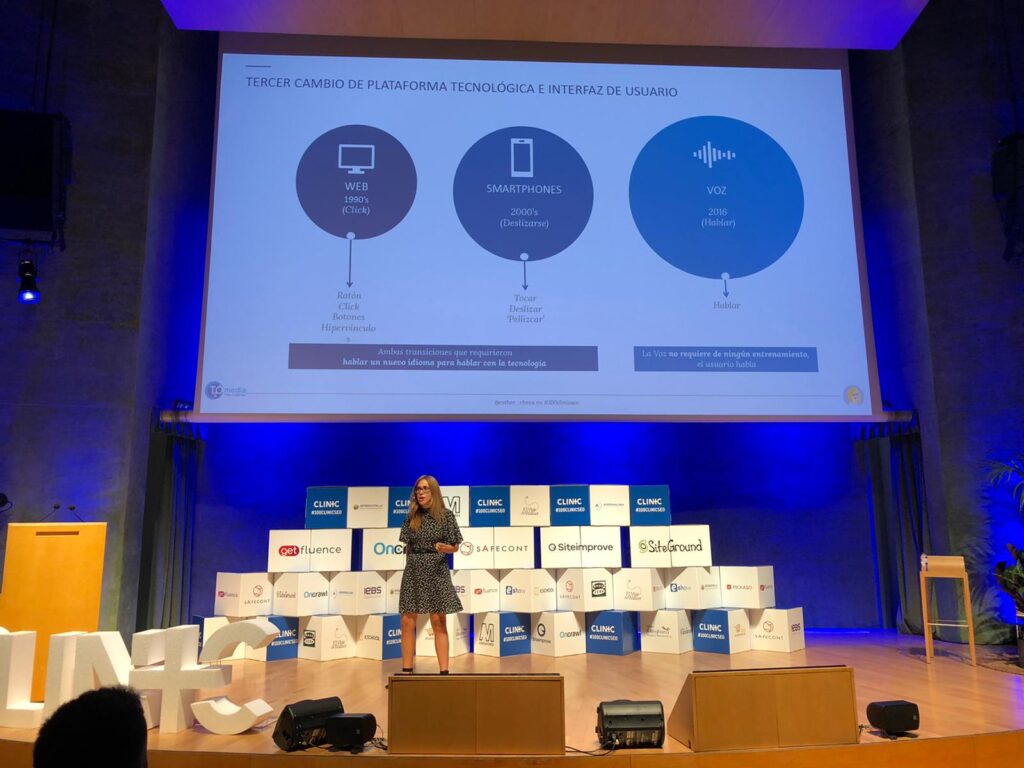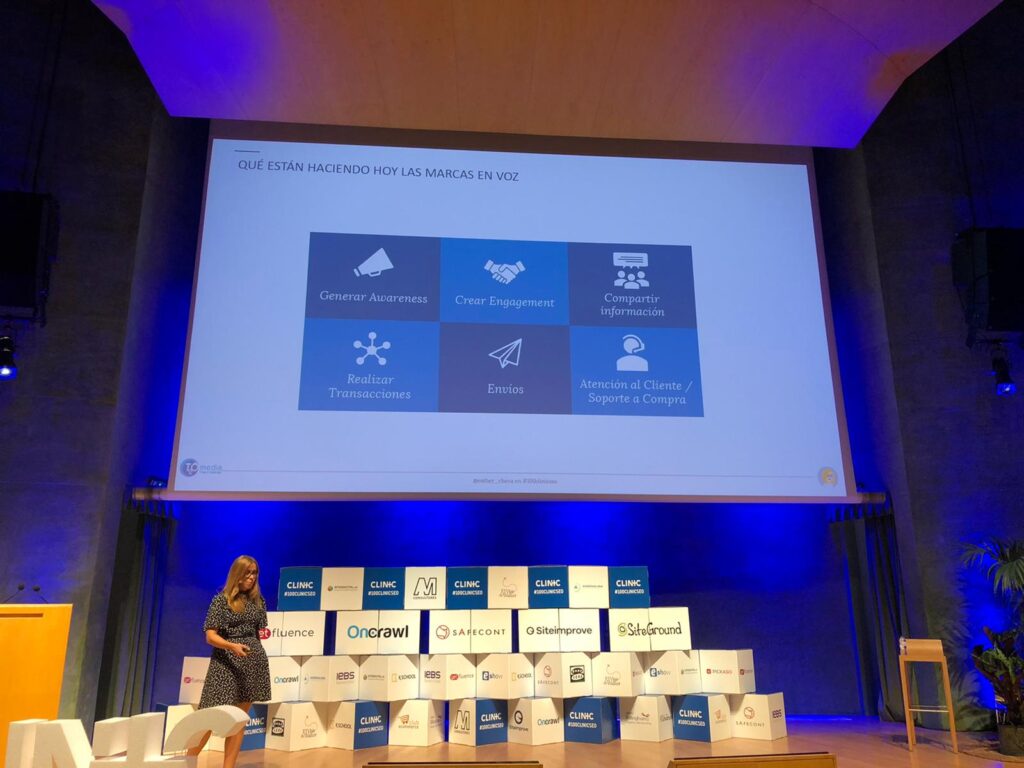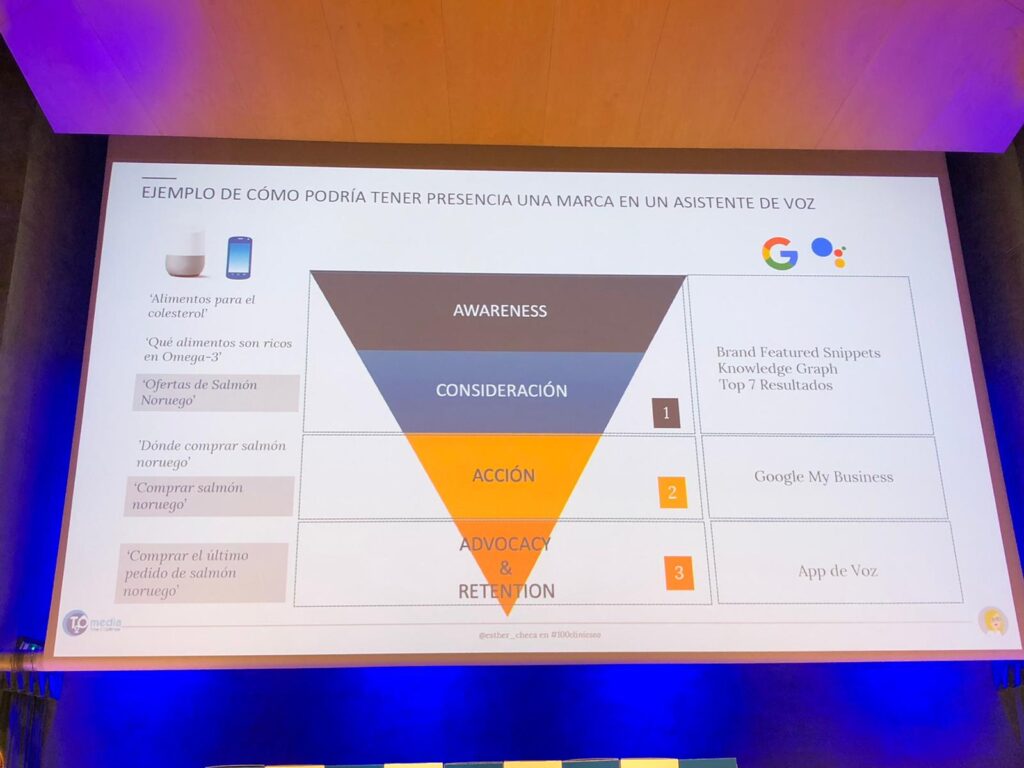Written by Fernando Maciá
Esther Checa (@esther_checa), Head Of Innovation at T2O media, talks about how people are sending and requesting information via voice assistants and what opportunity this presents for brands.
We moved from the mouse to the touch screen and from there to voice. We moved from a graphical environment to a voice interaction environment. Graphical interaction allows long processes because we see the information, while voice interaction requires short, immediate processes. It is a change of plant form, user interface, web standards with relatively open access to consumers and part of the proprietary ecosystems of the Web.
Ecosystem
Traffic acquisition was led by Google, while in e-commerce it is Amazon that has led the way. Competing for our attention are Apple, Google, Samsung, Amazon, all of which have taken control of voice-activated devices.
We have 53.4 million mobile lines and the leading operating systems are Siri, Alexa, Android.
Functionalities
Native: set the alarm, turn on the lights, set a timer.
Skills: extend the wizard’s functionalities with informational, transactional and support applications.
There is a process of categorization of consumption by voice; Amazon or Google are open environments. Google has all the indexing of the graphic web. Amazon has to enter into agreements with third parties.
Siri is a closed environment. Bixby does provide an option for capsule developments.
Answer engine optimization/SEO: with descriptive metadata, voice apps, reviews, ratings, commercial interests. There are two forms of algorithms: from the graphical web and from the speech context.
There are voice-only (smart speakers), voice-first (smart screens) or voice-added (smartphones) assistants. Voice assistant information comes out of the search results in the case of Google. In product categories, Amazon is the leader due to its product base, plus agreements with third parties.
The algorithm is evolving frenetically: information is presented in different types of formats on the screen. The voice assistant pulls information from the knowledge graph, My Business or featured snippets. The reflection is: if I want to be present on both platforms, I have to understand the technologicalframework of each platform and how I can be present on both.
In product and transactional searches, Amazon connects to the catalog (Amazon Choice).
There are 56,000 skills developed for Amazon Alexa compared to only 4,200 Google Assistant actions (in the United States).
Problems
Discovery is the main problem. They need to help the user find content that solves something for them. From the user, there is a large fragmentation of searches in the voice environment. Searches are distributed across multiple devices (smartphone, smart speaker, in car voice assistant, laptop…). The context determines the type of search made by the user.
The tasks for which voice is used are: setting music, time, funny questions, alarms, timers, but also searches.
47% of users say they use voice primarily on smartphones, smartspeakers (31%) followed by tablets, laptops and wearables.
We are now in a mobile graphical web context and we are going to have to work on the impact of voice search depending on the context. It’s going to multiply and we have to understand the context of the user.
Type of applications
Answer general questions, provide services with our products or help sales processes. Voice is not a channel: it is another platform on which to develop the consumer experience. Help them with purchasing, product tracking, restocking previous orders, etc.
What brands do
We can stand out with local and informational searches. It is necessary to be in the featured snippets. When information becomes transactional, that’s where Google has no muscle. But on the transactional side it is Amazon that has muscle.
The bet is being made evenly between Amazon Alexa and Google Assistant, while on Siri, Cortana or Bixby, much less.
Build the voice experience from the simplest to the most concrete. Build a voice experience that works. It’s a very failure-sensitive context: we don’t put up with mistakes.
From there, add content to build engagement, rich content.
Understand user contexts: smartphone, home, mobile. These contexts change the intention.
We move from buyer persona to place-ona based on how we expect to interact with users.
Patience is minimal: there is low tolerance for errors. If users don’t see value, they will move on to something else immediately.
Recommendations
Consistency of content with dynamic and active updating. Adaptation of digital assets to the mobile environment.
Role of voice in the brand ecosystem and connect voice strategy to the rest of the brand strategy. It cannot be an independent entity.
The organic integration of this new communication channel with the rest of the brand environment will cause the consumer to naturally and organically stumble upon the voice experience. With much less friction.
Voice is going to be a reality. As users, professionals and brands, we must understand the role that voice will play in this ecosystem: voice-search intent.



